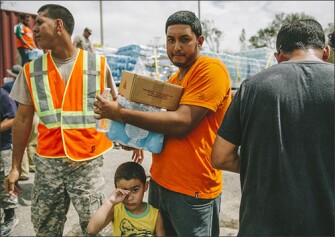
Updated
An Education Week reporter and photojournalist went to Puerto Rico this month to see firsthand the devastation on the island after Hurricane Maria. They learned that the island’s education secretary hasn’t even heard from 20 percent of Puerto Rico’s nearly 1,200 schools, and many people are still struggling to access basic supplies, including food and water.
When Education Week shared these stories on social media, readers wanted to know: How can we help? People asked about sending supplies. Teachers even asked if they could travel to the island to teach while schools and communities rebuilt.
See also: Puerto Rican Schools Offer Lifeline in Devastated Communities
Here are some ways educators can help:
Donate cash. Most organizations are asking for cash in the wake of a disaster, since that’s easier to route than supplies. Here are a few options:
- The American Federation of Teachers has a disaster relief fund set up for Puerto Rico.
- Save the Children is on the ground assisting families and children. (The charity is also providing aid to the Dominican Republic, which was battered by Hurricane Maria as well.)
- United for Puerto Rico, a campaign spearheaded by the Puerto Rican first lady, promises that 100 percent of proceeds will go to disaster relief.
- UNICEF is providing emergency relief kits to children in Puerto Rico. A donation of $28 will give a child supplies like water purification tablets, soap, toothpaste, detergent, and sanitary pads.
- Charity Navigator has compiled a list of highly rated organizations assisting the island.
Donate supplies. Perhaps you want to organize a supply drive at your school. Some organizations are accepting donated supplies, including United for Puerto Rico. That group is accepting both construction supplies and emergency supplies, including canned foods, baby formula, bottled water, canned and dry pet food, and medicines. Donate through this page. (Select Puerto Rico as the recipient.)
A Florida teacher whose mother and two sons live in Puerto Rico asked his students and community to donate emergency supplies. They collected more than 25 pallets of supplies.
Adopt a school. Dorina Sackman, the 2014 Florida Teacher of the Year, has launched an initiative where schools on the U.S. mainland can adopt a school on the island. The effort, called “Materials for Maestros,” is starting with the Thomas Alva Edison School, a preK-12 private school. Sackman’s friend, Vivian Rivera Maysonet, teaches there. Teachers and students there are asking for supplies like water, paper, books, coloring books, markers, and hand sanitizer. They are also asking for encouraging letters to students from students, and letters to teachers from teachers.
The school will also share these supplies and letters with other schools in the area, Sackman wrote in a letter to her National Network of State Teachers of the Year colleagues.
Volunteer. Puerto Rico still has to stabilize before accepting volunteers, so don’t book your flight just yet. Instead, sign up to volunteer via Voluntary Organizations Active in Disaster (VOAD), which will vet requests. You can note if you have a special skill set (wanted: language skills, medical skills, and experience with mental health), and the organizers will contact you once the island is ready for volunteers.
(More than two dozen AFT nurses and health professionals went to Puerto Rico for two weeks to help. AFT President Randi Weingarten will be traveling to the island later this month.)
Need some inspiration? Read about Isabel Rodriguez Santos, Puerto Rico’s 2007 Teacher of the Year. She spoke to Education Week about how she’s trying to help her students as their school works to reopen. The challenges are daunting, but she’s determined to stay.
“I have relatives in the U.S. who call and say, ‘Come on, you got a profession, you speak English, you’ve got to move here.’ I say no,” Rodriguez Santos said. “This is my island. My students need me.”

Isabel Rodriguez Santos, right, stands with her 14-year-old daughter.
(Update: This story was updated with an additional way teachers from the mainland can help.)
See also: How Teachers Can Help With Hurricane Harvey Relief
